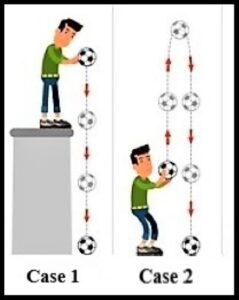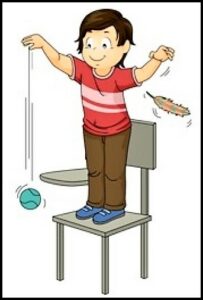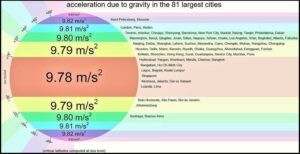The gravitational acceleration example explain an object’s free-fall acceleration towards the earth. The article discusses about detailed insights on such gravitational acceleration example that listed below:
Falling Objects
Let’s explore the gravitational acceleration example illustrating the gravitational acceleration on falling objects.
When we release the ball from a specific height to the ground, it accelerates downward due to gravity force. Suppose there are no other types of forces acting on a falling ball other than gravity. In that case, it drops with a constant gravitational acceleration value of 9.8 m/s2, which is determined by Newton’s laws.

on Falling Ball
(credit: shutterstock)
Case 1: When we throw the ball horizontally along the ground, its velocity continuously increases, except it disturbs other objects. If we keep a ball before throwing, its velocity is zero. It begins increasing after it is released towards the ground. The greater the height from ball release, the faster the it will travel.
Since no contact or non-contact force like air resistance or electromagnetic force acting on moving ball, the gravity force produces constant gravitational acceleration while moving along and towards the ground.
Case 2: Suppose we throw the same ball vertically into the air. Its velocity first increases but then decreases to zero since the ball stops at a certain height. When an object moves away from the ground, its velocity decreases due to air drag or air resistance.
But once a ball’s weight or gravity force overcomes the air resistance, a ball inverts the direction and falls towards the ground with constant gravitational acceleration.
The gravitational acceleration is constant free-fall acceleration which an object experience when only gravity force acts due to its weight mg.
Read more about Gravitational Acceleration.
Weight
Let’s explore several gravitational acceleration example illustrating the gravitational acceleration due to weight.
Suppose we drop a piece of feather and a ball simultaneously. Of course, the ball accelerates rapidly due to its heavy weight. The feather has a small weight that cannot overcome the air resistance, which lowers its acceleration from constant gravitational acceleration.

(credit: shutterstock)
The mass is a physical quantity that measures an object’s matter, whereas the weight measures how much an object having mass can accelerate when no other forces act on it. That’s why gravity force is also termed as weight force.
When fruit grows on the trees, it hangs from branches for a very long period. That is because its weight is unable to succeed the air resistance of the surrounding atmosphere. But once the fruit develops more, its mass also increases, so does its weight which overcomes the air resistance; the fruit finally falls towards the ground.
The rock boulder has a larger mass than marble and exhibits a more vital gravity force. But it also exhibits greater friction when it rolls or slides on the ground surface, which opposes its motion. That’s the reason the boulder accelerates at an equal rate as the light marble.
Suppose we drop feather and bottle simultaneously in a vacuum where no air resistance or friction exists; both will fall at constant gravitational acceleration as there is one force acting on both. i.e., gravity force.
Read more about Gravitational Acceleration without Mass.
Weightlessness
Let’s explore the gravitational acceleration example illustrating the weightlessness condition in space.
The astronauts feel “weightlessness” orbiting inside the space shuttle around the earth. That is because the gravitational acceleration depends only on the large mass of Earth and does not depend on the small masses of astronauts; hence their small masses cancel out while determining the g value.

Gravitational Acceleration in Space
(credit: shutterstock)
Have you noticed any free objects floating inside the space shuttle? The condition is termed as ‘weightlessness’. If one astronaut drop a small device inside the shuttle, it accelerates towards the earth. But the astronaut accelerates at the equivalent rate; so that the falling device remains at the same position relative to the astronaut.
The earth with a large mass exerts the gravity force on the shuttle. Since the shuttle, all its inside accessories and astronauts have tiny masses compared to earth; hence, it is overlooked. That’s why the astronaut and the falling device encounter weightlessness, and both float inside the shuttle.
In previous articles, we already discovered the formula for gravitational acceleration g by using Newton’s laws as,
g=GM/r2
Substituting all values for earth planet, mass M as 6 x 1024 kg the distance between the earth and an object as 6.38 x 106 m and gravitational constant G as 6.67 x 10-11 Nm2/kg2, the gravitational acceleration g for the earth is 9.8 m/s2.
Therefore, depending on the earth’s constant mass and the distance between the shuttle and earth, the entire shuttle is in constant gravitational acceleration with respect to the earth.
Read more about How to calculate Mass from Gravitational Force.
Different Planets
Let’s explore the gravitational acceleration example illustrating the gravitational acceleration on different planets.
Suppose a man’s weight is 60 kg on the earth. In that case, his weight on the moon is 6 kg because the gravitational acceleration g value on the moon is about 1/6th of the gravitational acceleration g value of the earth. That means the g value changes as per the mass of gravitating planets.

on Different Planets
(credit: shutterstock)
Because of the shorter g value of the moon, the astronaut can walk around its surface despite a heavy spacesuit. Whereas, in Jupiter planet, where the g values are three times larger than the g value in the earth, the astronaut struggles to stand up even inside the space shuttle.
Read more about How to calculate Mass from Force and Distance.
Satellite
Let’s explore the gravitational acceleration example illustrating the gravitational acceleration on satellite which is moving away from earth.
When the satellite goes away from the earth at height h, the radius r between them becomes (r+h). The air resistance force overcomes the gravity force on the satellite. Hence, the gravitational acceleration g value on an object is varied when it goes away from the earth surface.

Due to gravity force, the skydiver drops with constant gravitational acceleration when he jumps from the plane. But when the skydiver opens the parachute, it starts flying away from the earth. The parachute opposes the gravity force, which reduces the skydiver’s rapid falling velocity and supports the skydiver to land safely.
Altitude and Longitude
Let’s explore the gravitational acceleration example illustrating different values of gravitational acceleration on altitude and longitude.
Even though the gravitational acceleration g magnitude is the equivalent on the earth’s surface, its values range from 9.764 m/s2 to 9.834 m/s2 based on altitude and longitude and. It is also more significant at the earth’s poles than at its equator.

on altitude and longitude
(credit: physics.info)
Since the acceleration is a vector quantity, its direction changes as per an object’s location. The gravitational acceleration forever acts towards the earth’s centre; hence, it is in the opposite direction at the north pole. But since the earth’s circumference is huge, even if we move from one place to another in a city, the direction of g changes very little.
The g value slightly alters depending on geology. The g value 9.8 m/s2 is identical for all the objects near the earth’s surface and holds for altitudes up to +10 km and depths down to -20 km.
Also Read:
- Frictional force and centripetal acceleration
- How to find tension force with acceleration
- How to find acceleration due to gravity on another planet
- Acceleration formula
- Tangential acceleration formula
- How to find angular acceleration of a wheel
- How to find mass with acceleration and force
- How to find acceleration due to gravity with distance and time
- How to find acceleration kinematics
- How to find acceleration speed time graph

Hello, I’m Manish Naik completed my MSc Physics with Solid-State Electronics as a specialization. I have three years of experience in Article Writing on Physics subject. Writing, which aimed to provide accurate information to all readers, from beginners and experts.
In my leisure time, I love to spend my time in nature or visiting historical places.
Looking forward to connecting you through LinkedIn –